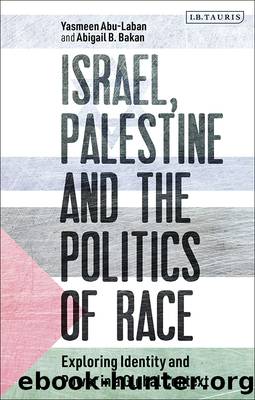Israel, Palestine and the Politics of Race by Yasmeen Abu-Laban;Abigail B. Bakan;

Author:Yasmeen Abu-Laban;Abigail B. Bakan;
Language: eng
Format: epub
Publisher: Bloomsbury UK
PART THREE
THE ISRAEL/PALESTINE RACIAL CONTRACT: REBRANDING AND RESISTANCE
7 ISRAEL’S REBRANDING CAMPAIGN AND THE POLITICS OF GENDER
Introduction
Images of gender and governance are critical to understanding the evolution of “brand Israel” in the Western popular imaginary, and, since the 2000s, in Israel’s “rebranding campaign.” In this chapter, we argue that rebranding Israel is a state-led process of reframing apartheid-like policies to be read as democratic, modern, and inclusive of gender and sexual diversity. This process depends significantly on absenting Palestinians, and, relatedly, on Israeli colonial subjugation and the ongoing dispossession of Palestinians. It also relies on presenting alternative, and racialized, images of Palestinians as “culturally” undemocratic, violent, and sexist/patriarchal. These stereotypes belie the rich, diverse, and varied histories and experiences of Palestinians, while serving to advance the Israel/Palestine racial contract.
In what follows, we take a fourfold approach. First, we pick up a theme advanced earlier, namely the way in which the idea of “Israel” resonates in Western hegemony, but also show the relevance of gender and sexuality in theorizing this evolving national and global construction. While in its first two decades, Israel’s relevance in relation to the Christian Bible may have been critically important, in recent years, this marketing pitch has perhaps reached its best before date. Certainly, since September 11, 2001, there has been a greater shift toward what Jasbir K. Puar refers to as “homonationalism,” a process that is deeply implicated in Orientalist constructions of a mythical ascribed Muslim sexuality (2007: 4). Second, the chapter turns to consider Israel’s historic branding and rebranding around issues related to gender, specifically constructions of masculinity and femininity in relation to national discourses. Third, we address in greater detail a more recent feature in rebranding efforts that focus on gay rights, a development that critics have referred to as “pinkwashing” Israel’s apartheid policies. Using the specific example of attempts to ban the organization Queers Against Israeli Apartheid (QUAIA) from a major North American pride parade held annually in Toronto, Canada, we consider the contradictions of pinkwashing from the vantage point of LGBTQ (lesbian, gay, bisexual, transgender/transsexual, and queer/questioning) rights and human rights. Fourth, we conclude this chapter by turning attention specifically to the Palestinians as “Brand Israel’s” implicit other. While the Palestinian narrative is absented within Brand Israel, we consider the gendered dimensions of how Palestinians are imagined—both in Israel and in the West. We also consider the gendered impact of colonialism and occupation on the Palestinian population.
Gender, nation, and homonationalism after 9/11
As noted throughout this volume, there is an inherent contradiction in a polity that claims to be simultaneously open and inclusive, or democratic, while positing an exclusive core mission—insisting on Israel’s national identity as a distinctly “Jewish” state rather than a state of all its citizens. This contradiction, though perhaps more blatant on the international scene in recent years, has characterized Israel since its foundation in 1948 and lies at the heart of the Israel/Palestine racial contract. It is expressed through a collection of policies designed to eradicate the physical presence of
Download
This site does not store any files on its server. We only index and link to content provided by other sites. Please contact the content providers to delete copyright contents if any and email us, we'll remove relevant links or contents immediately.
| General | Discrimination & Racism |
Nudge - Improving Decisions about Health, Wealth, and Happiness by Thaler Sunstein(6668)
iGen by Jean M. Twenge(4716)
The Fire Next Time by James Baldwin(4375)
Adulting by Kelly Williams Brown(3705)
The Sports Rules Book by Human Kinetics(3616)
The Hacking of the American Mind by Robert H. Lustig(3603)
The Ethical Slut by Janet W. Hardy(3534)
Captivate by Vanessa Van Edwards(3320)
Mummy Knew by Lisa James(3181)
In a Sunburned Country by Bill Bryson(2965)
The Worm at the Core by Sheldon Solomon(2947)
Ants Among Elephants by Sujatha Gidla(2938)
Suicide: A Study in Sociology by Emile Durkheim(2623)
The Slow Fix: Solve Problems, Work Smarter, and Live Better In a World Addicted to Speed by Carl Honore(2587)
Humans of New York by Brandon Stanton(2389)
Handbook of Forensic Sociology and Psychology by Stephen J. Morewitz & Mark L. Goldstein(2385)
Blackwell Companion to Sociology, The by Judith R. Blau(2324)
The Happy Hooker by Xaviera Hollander(2284)
Outliers by Malcolm Gladwell(2272)
